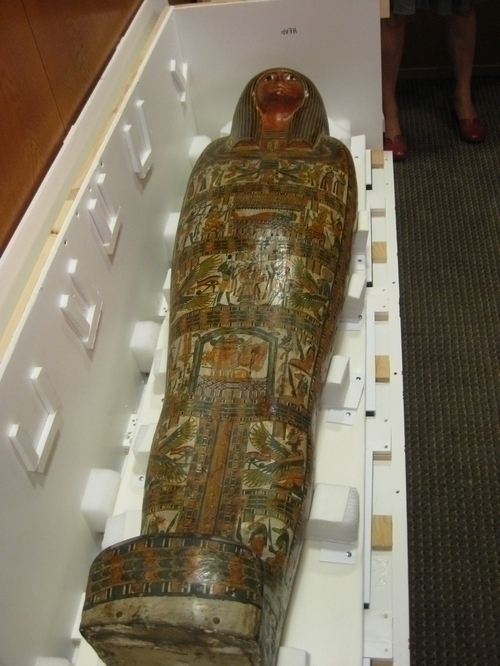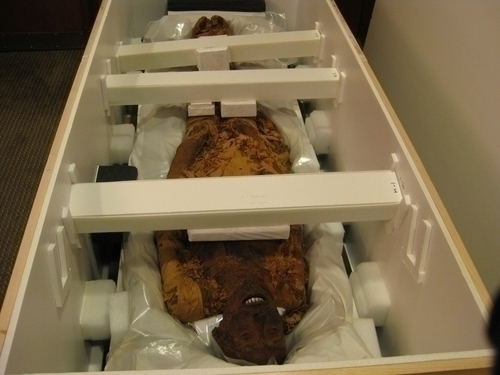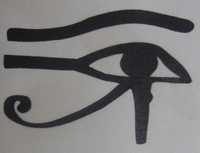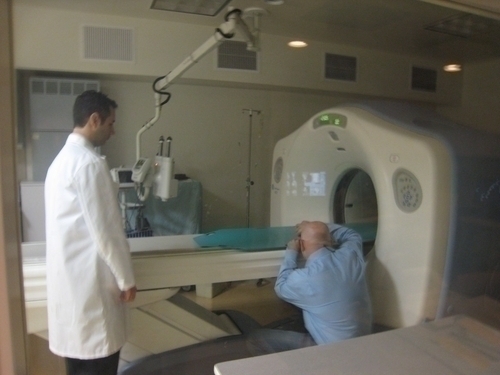Mummy Transport
As some of you may have seen from the recent press coverage, we took four of our Egyptian human mummies to North Shore University Hospital to be CT scanned—short for computed tomography. Although the bodies were well preserved with the sophisticated techniques employed by ancient Egyptians, they remain very fragile due to their age and being essentially composed of organic materials – skin, bone, tissue, hair, and textile.

Mummy of the “Lady” Hor Encased in Cartonnage. Linen, painted and gessoed. Circa 712-664 B.C.E. Third Intermediate Period. Second half of XXV Dynasty. 69 3/4 x 18 1/16 in. Charles Edwin Wilbour Fund. 37.50E
How would you pack and transport a mummy safely? At the Brooklyn Museum, we have as a part of the Registrar’s Department, one fine arts packer, Paul Speh. Art objects, especially Egyptian mummies, are not easy objects to pack. Working with the Registrars and Conservators, he came up with ingenious designs to safely hold and support the mummies for their trip to the hospital. We used a variety of polyethylene foam products to absorb shock, and vibration.

Mummy Pasebakhaemipet. Thebes, Egypt. ca. 1070-945 B.C.E. XXI Dynasty. Third Intermediate Period. 76 3/8 x 21 5/8 in. (194 x 55 cm). 08.480.2a-c
Additionally, for two of the most fragile mummies, we used radiation bags designed for use with patients undergoing types of radiation treatments. These bags are malleable and filled with polystyrene beads (much like a bean bag chair). They were manipulated under the mummies to fully conform and support their irregular shapes. The air is then drawn out with a vacuum to make a custom fitted full support.

The mummies, once properly packed for their journey, were transported using a fine arts transportation company. We used Marshall Fine Arts. Fine art shippers will have specially designed trucks that are climate controlled and have a specially designed suspension system to absorb vibration called air ride. Paul placed on each travel container, the hieroglyph of Wadjet—the eye of Horus—so that the mummies could be able to see where they were going.

Paul Speh measures the CT scanner with Dr. Jessie Chusid.
When we arrived at the hospital, before the truck was even opened to move the mummies inside, Paul surveyed the route, and ensured that all was in order, down to the inch.
The day proved exhausting for all of us (except maybe the mummies), but a wealth of information was obtained, not only about the individuals themselves, but about the ancient Egyptian techniques of mummification. All the staff at North Shore University Hospital were very accommodating and helpful, especially the doctors and radiologists who worked directly with us—Drs. Amgad Makaryus, Jesse Chusid, and Karen Lisk. We are excited about working with them to absorb and process the information.
Look for future postings on what we find out about each mummy.

Lisa Bruno is the head conservator of objects at the Brooklyn Museum, where she has been working since 1993. She has previously worked at the Art Institute of Chicago, and has had internships at The Cleveland Museum of Art, the Detroit Institute of Arts, and in private practice. She has a Masters Degree in Art Conservation from the University of Delaware, Winterthur Museum Art Conservation Department. She is a Professional Associate of the American Institute for Conservation.
